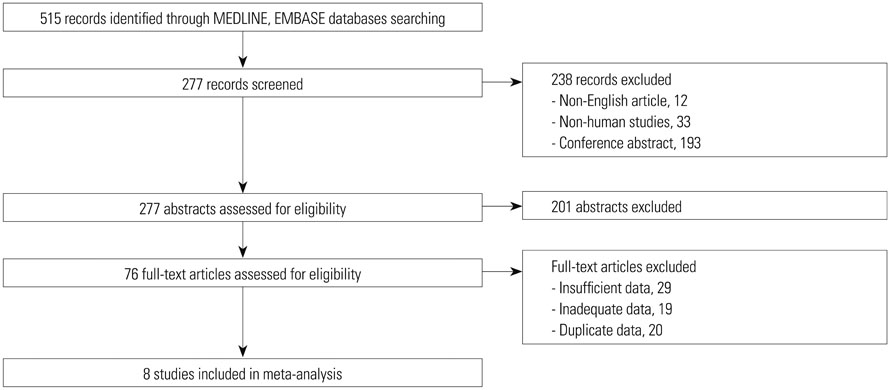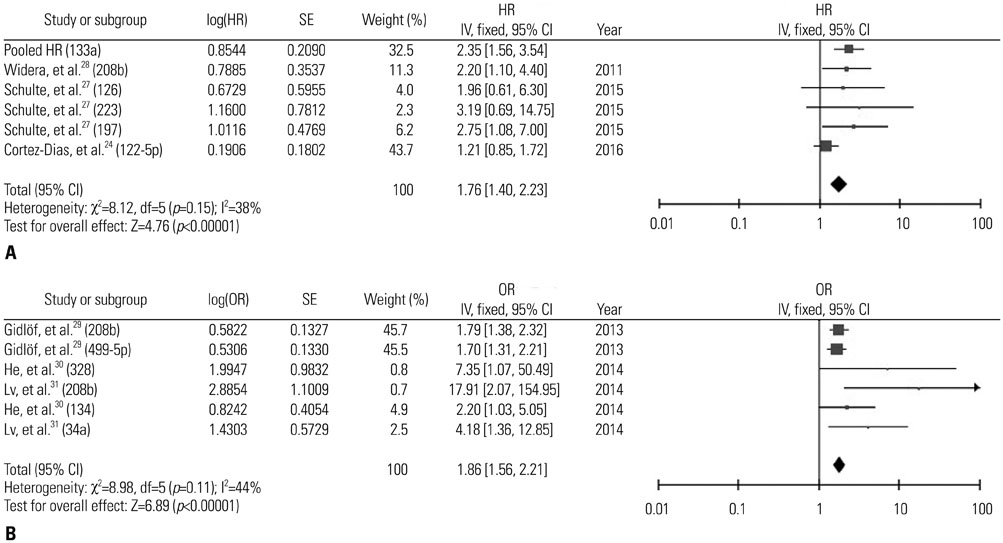Yonsei Med J.
2018 Jun;59(4):495-500. 10.3349/ymj.2018.59.4.495.
Prognostic Value of MicroRNAs in Coronary Artery Diseases: A Meta-Analysis
- Affiliations
-
- 1BEER, Busan Society of Evidence-based Mdicine and Research, Busan, Korea. yunhak10510@pusan.ac.kr
- 2Department of Family Medicine, BHS Han Seo Hospital, Busan, Korea.
- 3Department of Nuclear Medicine, Pusan National University Hospital, Busan, Korea.
- 4Department of Orthopaedic Surgery, Pusan National University Hospital, Busan, Korea.
- 5Analytics Group, Deloitte Consulting LLC, Seoul, Korea.
- 6Department of Anatomy, School of Medicine, Pusan National University, Yangsan, Korea.
- 7Department of Pharmacology, School of Medicine, Pusan National University, Yangsan, Korea.
- KMID: 2410904
- DOI: http://doi.org/10.3349/ymj.2018.59.4.495
Abstract
- PURPOSE
Coronary artery diseases (CADs) are the leading causes of death in the world. Recent studies have reported that differentially expressed microRNAs (miRNAs) are associated with prognosis or major adverse cardiac events (MACEs) in CAD patients. In a previous meta-analysis, the authors made serious mistakes that we aimed to correct through an updated systematic review and meta-analysis of the prognostic value of altered miRNAs in patients with CADs.
MATERIALS AND METHODS
We performed a systematic search of MEDLINE (from inception to May 2017) and EMBASE (from inception to May 2017) for English-language publications. Studies of CADs with results on miRNAs that reported survival data or MACEs were included. Data were extracted from each publication independently by two reviewers.
RESULTS
After reviewing 515 articles, a total eight studies were included in this study. We measured pooled hazard ratios (HRs) and 95% confidence intervals (CIs) of miRNA 133a with a fixed-effect model (pooled HR, 2.35; 95% CI, 1.56-3.55). High expression of miRNA 133a, 208b, 126, 197, 223, and 122-5p were associated with high mortality. Additionally, high levels of miRNA 208b, 499-5p, 134, 328, and 34a were related with MACEs.
CONCLUSION
The present study confirmed that miRNA 133a, which was associated with high mortality in CAD patients, holds prognostic value in CAD. More importantly, this study corrected issues raised against a prior meta-analysis and provides accurate information.
Keyword
MeSH Terms
Figure
Reference
-
1. Nabel EG. Cardiovascular disease. N Engl J Med. 2003; 349:60–72.
Article2. Roth GA, Forouzanfar MH, Moran AE, Barber R, Nguyen G, Feigin VL, et al. Demographic and epidemiologic drivers of global cardiovascular mortality. N Engl J Med. 2015; 372:1333–1341.
Article3. Roth GA, Nguyen G, Forouzanfar MH, Mokdad AH, Naghavi M, Murray CJ. Estimates of global and regional premature cardiovascular mortality in 2025. Circulation. 2015; 132:1270–1282.
Article4. Kim YH, Lee SJ, Seo KW, Bae JU, Park SY, Kim EK, et al. PAF enhances MMP-2 production in rat aortic VSMCs via a β-arrestin2-dependent ERK signaling pathway. J Lipid Res. 2013; 54:2678–2686.
Article5. Kim YH, Bae JU, Lee SJ, Park SY, Kim CD. SIRT1 attenuates PAF-induced MMP-2 production via down-regulation of PAF receptor expression in vascular smooth muscle cells. Vascul Pharmacol. 2015; 72:35–42.
Article6. Kim YH, Bae JU, Kim IS, Chang CL, Oh SO, Kim CD. SIRT1 prevents pulmonary thrombus formation induced by arachidonic acid via downregulation of PAF receptor expression in platelets. Platelets. 2016; 27:735–742.
Article7. Lozano R, Naghavi M, Foreman K, Lim S, Shibuya K, Aboyans V, et al. Global and regional mortality from 235 causes of death for 20 age groups in 1990 and 2010: a systematic analysis for the Global Burden of Disease Study 2010. Lancet. 2012; 380:2095–2128.8. Ha M, Kim VN. Regulation of microRNA biogenesis. Nat Rev Mol Cell Biol. 2014; 15:509–524.
Article9. Kim YH, Goh TS, Lee CS, Oh SO, Kim JI, Jeung SH, et al. Prognostic value of microRNAs in osteosarcoma: a meta-analysis. Oncotarget. 2017; 8:8726–8737.
Article10. Wiemer EA. The role of microRNAs in cancer: no small matter. Eur J Cancer. 2007; 43:1529–1544.
Article11. Fichtlscherer S, De Rosa S, Fox H, Schwietz T, Fischer A, Liebetrau C, et al. Circulating microRNAs in patients with coronary artery disease. Circ Res. 2010; 107:677–684.
Article12. Latronico MV, Condorelli G. MicroRNAs and cardiac pathology. Nat Rev Cardiol. 2009; 6:419–429.
Article13. D'Alessandra Y, Devanna P, Limana F, Straino S, Di Carlo A, Brambilla PG, et al. Circulating microRNAs are new and sensitive biomarkers of myocardial infarction. Eur Heart J. 2010; 31:2765–2773.14. Heneghan HM, Miller N, Kerin MJ. Role of microRNAs in obesity and the metabolic syndrome. Obes Rev. 2010; 11:354–361.
Article15. Mitchell PS, Parkin RK, Kroh EM, Fritz BR, Wyman SK, Pogosova-Agadjanyan EL, et al. Circulating microRNAs as stable bloodbased markers for cancer detection. Proc Natl Acad Sci U S A. 2008; 105:10513–10518.
Article16. Christopher AF, Kaur RP, Kaur G, Kaur A, Gupta V, Bansal P. MicroRNA therapeutics: discovering novel targets and developing specific therapy. Perspect Clin Res. 2016; 7:68–74.
Article17. Huang W. MicroRNAs: biomarkers, diagnostics, and therapeutics. Methods Mol Biol. 2017; 1617:57–67.
Article18. Chan D, Ng LL. Biomarkers in acute myocardial infarction. BMC Med. 2010; 8:34.
Article19. Cao W, Guo Q, Zhang T, Zhong D, Yu Q. Prognostic value of microRNAs in acute myocardial infarction: a systematic review and meta-analysis. Int J Cardiol. 2015; 189:79–84.
Article20. Shao Y, Geng Y, Gu W, Huang J, Ning Z, Pei H. Prognostic significance of microRNA-375 downregulation in solid tumors: a meta-analysis. Dis Markers. 2014; 2014:626185.
Article21. Wang J, Yu M, Guan S, Zhang G, Wang J, Cheng Y. Prognostic significance of microRNA-100 in solid tumors: an updated meta-analysis. Onco Targets Ther. 2017; 10:493–502.
Article22. Stang A. Critical evaluation of the Newcastle-Ottawa scale for the assessment of the quality of nonrandomized studies in meta-analyses. Eur J Epidemiol. 2010; 25:603–605.
Article23. Egger M, Davey Smith G, Schneider M, Minder C. Bias in meta-analysis detected by a simple, graphical test. BMJ. 1997; 315:629–634.
Article24. Cortez-Dias N, Costa MC, Carrilho-Ferreira P, Silva D, Jorge C, Calisto C, et al. Circulating miR-122-5p/miR-133b ratio is a specific early prognostic biomarker in acute myocardial infarction. Circ J. 2016; 80:2183–2191.
Article25. Eitel I, Adams V, Dieterich P, Fuernau G, de Waha S, et al. Relation of circulating MicroRNA-133a concentrations with myocardial damage and clinical prognosis in ST-elevation myocardial infarction. Am Heart J. 2012; 164:706–714.
Article26. Ke-Gang J, Zhi-Wei L, Xin Z, Jing W, Ping S, Xue-Jing H, et al. Evaluating diagnostic and prognostic value of plasma miRNA133a in acute chest pain patients undergoing coronary angiography. Medicine (Baltimore). 2016; 95:e3412.
Article27. Schulte C, Molz S, Appelbaum S, Karakas M, Ojeda F, Lau DM, et al. miRNA-197 and miRNA-223 predict cardiovascular death in a cohort of patients with symptomatic coronary artery disease. PLoS One. 2015; 10:e0145930.
Article28. Widera C, Gupta SK, Lorenzen JM, Bang C, Bauersachs J, Bethmann K, et al. Diagnostic and prognostic impact of six circulating microRNAs in acute coronary syndrome. J Mol Cell Cardiol. 2011; 51:872–875.
Article29. Gidlöf O, Smith JG, Miyazu K, Gilje P, Spencer A, Blomquist S, et al. Circulating cardio-enriched microRNAs are associated with long-term prognosis following myocardial infarction. BMC Cardiovasc Disord. 2013; 13:12.
Article30. He F, Lv P, Zhao X, Wang X, Ma X, Meng W, et al. Predictive value of circulating miR-328 and miR-134 for acute myocardial infarction. Mol Cell Biochem. 2014; 394:137–144.
Article31. Lv P, Zhou M, He J, Meng W, Ma X, Dong S, et al. Circulating miR-208b and miR-34a are associated with left ventricular remodeling after acute myocardial infarction. Int J Mol Sci. 2014; 15:5774–5788.
Article32. Devaux Y, Vausort M, McCann GP, Kelly D, Collignon O, Ng LL, et al. A panel of 4 microRNAs facilitates the prediction of left ventricular contractility after acute myocardial infarction. PLoS One. 2013; 8:e70644.
Article33. Olivieri F, Antonicelli R, Spazzafumo L, Santini G, Rippo MR, Galeazzi R, et al. Admission levels of circulating miR-499-5p and risk of death in elderly patients after acute non-ST elevation myocardial infarction. Int J Cardiol. 2014; 172:e276–e278.
Article34. Bartel DP. MicroRNAs: genomics, biogenesis, mechanism, and function. Cell. 2004; 116:281–297.35. Kano M, Seki N, Kikkawa N, Fujimura L, Hoshino I, Akutsu Y, et al. miR-145, miR-133a and miR-133b: tumor-suppressive miRNAs target FSCN1 in esophageal squamous cell carcinoma. Int J Cancer. 2010; 127:2804–2814.
Article36. Liu N, Bezprozvannaya S, Williams AH, Qi X, Richardson JA, Bassel-Duby R, et al. microRNA-133a regulates cardiomyocyte proliferation and suppresses smooth muscle gene expression in the heart. Genes Dev. 2008; 22:3242–3254.
Article37. Vo NK, Dalton RP, Liu N, Olson EN, Goodman RH. Affinity purification of microRNA-133a with the cardiac transcription factor, Hand2. Proc Natl Acad Sci U S A. 2010; 107:19231–19236.
Article38. Wu ZS, Wang CQ, Xiang R, Liu X, Ye S, Yang XQ, et al. Loss of miR-133a expression associated with poor survival of breast cancer and restoration of miR-133a expression inhibited breast cancer cell growth and invasion. BMC Cancer. 2012; 12:51.
Article39. Kuwabara Y, Ono K, Horie T, Nishi H, Nagao K, Kinoshita M, et al. Increased microRNA-1 and microRNA-133a levels in serum of patients with cardiovascular disease indicate myocardial damage. Circ Cardiovasc Genet. 2011; 4:446–454.
Article40. Wang R, Li N, Zhang Y, Ran Y, Pu J. Circulating microRNAs are promising novel biomarkers of acute myocardial infarction. Intern Med. 2011; 50:1789–1795.
Article
- Full Text Links
- Actions
-
Cited
- CITED
-
- Close
- Share
- Similar articles
-
- Analysis of Circular RNAs in the Coronary Arteries of Patients with Kawasaki Disease
- Pain and Associated Symptoms in Patients with Acute Coronary Syndrome and Stable Coronary Artery Diseases: A Comparative Study
- Three Cases of Coronary Artery Fistula from Right Coronay to Left Ventricle
- Congenital Absence of Left Circumflex Coronary Artery: Circumflex Artery Extended from Right Coronary Artery
- Past, Present, and Future of Left Main Coronary Artery PCI




